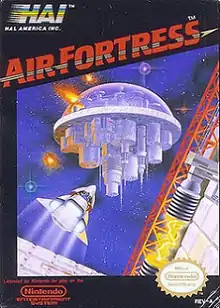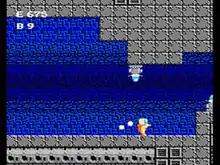Air Fortress
Air Fortress (空中要塞) is a video game published in Japan for the Famicom in August 1987, in North America for the Nintendo Entertainment System in September 1989 after an initial test release of 385 copies in 1987,[1] and a PAL release exclusively in Australia in 1989.[2]
| Air Fortress | |
|---|---|
 Box art of Air Fortress NES version | |
| Developer(s) | HAL Laboratory KAZe (some game design, graphics) |
| Publisher(s) | HAL Laboratory |
| Designer(s) | Hiroaki Suga |
| Composer(s) | Hideki Kanazashi |
| Platform(s) | Nintendo Entertainment System |
| Release |
|
| Genre(s) | Horizontally scrolling shooter, Run and gun |
| Mode(s) | Single-player |
Story
The people of the planet Farmel, having recently gained the technology for space travel, eagerly explored the galaxy only to find a herd of monstrous "Air Fortresses" moving in their direction. They quickly discovered that the Fortresses behaved like interstellar locusts, consuming all of the resources and living things in their path. The Space Federation sent their mightiest fleet, which was quickly eliminated by the powerful Fortresses. In a final gambit they send a single warrior named Hal Bailman, outfitted with a shielded spacesuit, powerful weapons, and small "lightship" to infiltrate the Fortresses and destroy them from the inside out.[3]
Gameplay
As Hal Bailman, the player infiltrates the progressively more challenging Air Fortresses. Each Air Fortress has two levels: the Air Base and the Fortress itself.
Air Base
On approach to the Air Fortress, Hal Bailman battles the enemy from his lightship. The gameplay is that of a side-scrolling shooter. During this phase, the player has three attempts to successfully reach the Air Lock that grants access to the Air Fortress. Along the way, the player must dodge a variety of flying enemies and space station parts. The player also has a chance during this phase to collect energy and "crash beam bullets," a more powerful ammunition that is limited in supply, that can be used inside the Fortress.
In this mode of play, a single hit will destroy the player's ship. In the Japanese version, if Hal collides with an enemy while on his lightship he must restart the approach sequence from the beginning; however, in the American version the player will automatically be respawned from the same point at which his ship was destroyed, provided that they have extra lives.
Air Fortress
Inside the Fortress, the game becomes an action-adventure game. The player now has more control over where they go, and finding one's way through the massive Fortresses is one of the major challenges of the game. The player must navigate through the maze, fight off enemy robots, security devices, and spacemen with their beam weapon, locate and destroy the central core of the Fortress, and find their ship to escape. The last is perhaps the most difficult part, since the Fortress explodes shortly after the core is destroyed and the player only has a short window of time in which to escape, with the exit never situated in the same place as where the player entered the maze.
Promotion
HAL America offered Air Fortress by mail order through a national advertising campaign. Players who purchased the game through HAL received a free Air Fortress T-shirt.
Credits

Air Fortress was developed by Japanese video game maker HAL Laboratory. "SUGA," the password for the final air fortress, is a reference to Air Fortress director, game designer, and programmer Hiroaki Suga. While the US version credits sound composer Hideki Kanazashi as "Rodeo Kanagushi", the Japanese version credits him as "Jumper Kanagushi".
References
- "Game review: Hal's Air Fortress for #Nintendo #NES". 8-bitcentral.com. 8-Bit Central. Retrieved 11 December 2015.
- "Air Fortress Release Information for NES - GameFAQs". gamefaqs.com. CBS Interactive Inc. Retrieved 11 December 2015.
- "Air Fortress for NES (1987) - MobyGames". mobygames.com. Blue Flame Labs. Retrieved 11 December 2015.